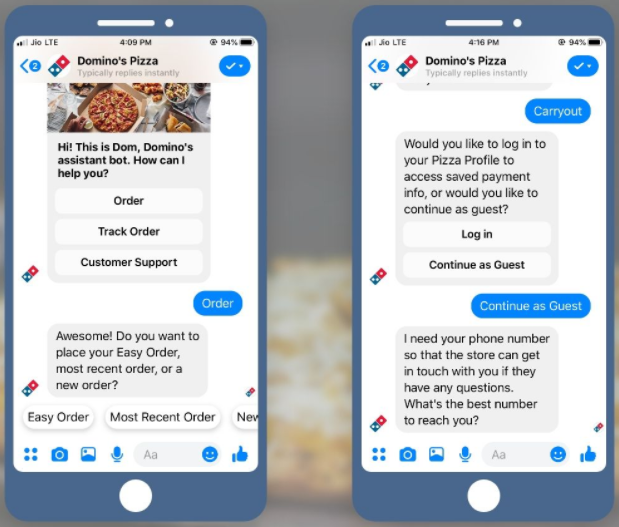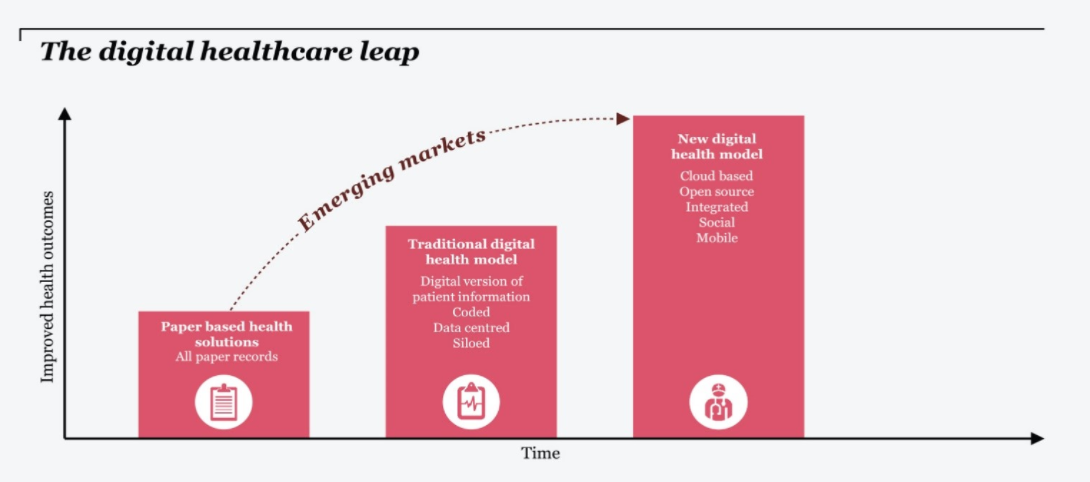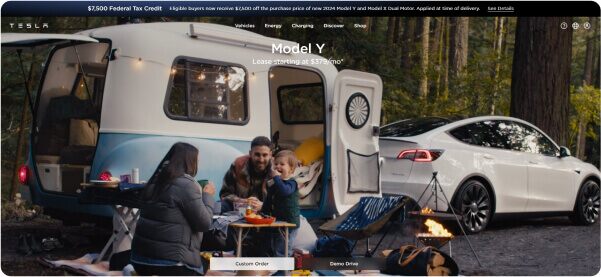15 Successful Examples of Digital Business Transformation
- June 10, 2021
- 17 mins read
- Listen

Businesses are not just adapting; they’re undergoing a profound transformation in this era. Organizations are reshaping their operations and enhancing customer experiences to stay ahead of the competition.
In this digital transformation, it’s not just about adopting the latest gadgets or upgrading software. It’s a holistic revolution that transcends traditional boundaries to redefine how businesses operate, connect with their audience, and ultimately, thrive in the fast-paced digital age.
In this article, we’ll explore the real-world examples of digital transformation that transcend industries to showcase how forward-thinking companies are not merely embracing change. But they’re leading the charge toward a future where technology is not just a tool but a strategic ally.
What is Digital Transformation?
Digital transformation is defined as the integration of digital technology into all different areas of a business, fundamentally revamping the way you operate and deliver value to the customers. It refers to a radical rethinking of how an organization uses technology, people, and processes to fundamentally change business performance.
The digital transformation of businesses widely differs based on the organization’s specific challenges and demands; however, there are a few constants that all businesses should consider as they start on it. The reimagining of business in the digital age is digital transformation.
As it is a wider concept several factors drive your degree of digitization. It includes the following:
- Technology – It influences businesses with significant benefits on the operations, as well as certain complexity levels of its integration.
- Demand – Customers are the ones who demand and they now expect a shopping experience that is seamless and intuitive.
- Behavior – Consumers directly impact behavior, who have expectations while shopping when it comes to your integrated technology.
Key Elements of Digital Transformation
The word “Digital” is driven by the rapid adoption of technology and “Transformation” refers to how an organization is built to change, innovate, and reinvent over the traditional methods. However, there are important elements that help businesses to create successful digital transformation strategy examples.
Here are the key attributes creating good digital transformation examples
- Plan a digital business strategy – It is vital to outline an effective digital transformation strategy that defines the end goals of your business.
- Proper customer engagement – Your business should engage with customers by understanding their needs and aligning service to their requirements.
- Define the process – A process plays a very important role in creating successful digital transformation examples.
- Implement the right tools & technology – It is essential to adopt the right tools and technology based on your business needs to deliver an excellent customer experience.
- Make data-driven decisions – Using data and analytics provides actionable insights that help in evidence-based decision-making.
How Does Digital Transformation Impact Businesses?
The benefits of digital transformation include increasing conversions, enhancing customer engagement, and gaining a competitive edge. However, there are key areas where digital transformation has a significant impact as follows:
1. Increased Revenue
One of the key aspects of adopting digital transformation technologies is to change the sales process. Leveraging digital technology can be more easily accessed by a wider market and reached by businesses of all sizes and from various fields.
2. Unified Customer Data
Streamlining the customer experience is an important common goal for the digital transformation business model. When all available data is collected and centralized, it becomes easier for customer support agents to solve customer requests timely and efficient.
3. Optimized Workflow
Successful digital transformation is all about efficiency and connectedness. For businesses taking the digital transformation strategy further, the areas of improvement include increased collaboration among employees of different levels and improved performance management.
4. Improved Customer Experience
Customers are the most important stakeholders of any organization. Digital transformation (DT) helps businesses provide an excellent customer experience and serve them better. DT helps to facilitate through connecting the customer data across the organization in one source.
5. Decreased Operating Costs
Companies are constantly searching to improve the efficiency of their processes. With the digital transformation business model, the operating costs are decreased by reducing time in the execution of processes, eliminating partial tasks, and incorporating new functionalities.
15 Best Digital Transformation Examples and Key Takeaways
Successful digital transformation takes businesses to a new level of growth. If you don’t have any digital transformation ideas in place, then have a look at some of the best examples of digital technology & learn how they keep their competitiveness in the global market.
Many companies have set good examples of digital technology by embracing the latest technology to achieve their business goals. Check out how companies have approached the process with digital transformation ideas and how they achieved the desired results.
1. BFSI – Commercial Bank of Kuwait (CBK) Use of Video Chat
Digital transformation is totally changing the entire game for banking, financial services, and insurance (BFSI) sectors. They are greatly relying on video collaboration for businesses to build long-term face-to-face relationships.
Commercial Bank of Kuwait (CBK) is a good business transformation example.
The bank implemented REVE Chat’s face-to-face video chat solution. Their main goal was to increase user engagement through online banking operations and deliver an advanced digital banking experience.
The bank has marked an increase in online engagement and reduced the number of touchpoints to resolve the issues.
Key takeaways
- For communicating the technical concepts and complex form fill-up, combining video chat and co-browsing can deliver effective solutions.
- You can develop friendly communication with customers that positively impacts customer relationships and deliver faster responses in real-time.
2. Virtual Collaboration – Use Co-browsing to Improve CX
Using the advanced co-browsing solution enables agents to avoid the tedious back-and-forth questions that are required when the agent is trying to figure out what the customer is actually looking at. Is it the wrong link? The wrong tab? Is it the wrong website altogether?
Here are the latest trends developing in the co-browsing domain.
- Co-browsing for mobile apps – According to CNBC, 72.6% of smartphone owners will use their devices to access the internet by 2025. Co-browsing technology is being adopted by new markets where mobile apps offer real-time customer support.
- Visual customer assistance – When a customer needs assistance, co-browsing allows the agent to see what is visible within the customer’s browser. However, visual support goes a step further by allowing the agent to see the customer’s physical environment via their smartphone.
- Enhance interactions with AI – In case a customer reports billing issues, AI bots can interact and collect basic information & needs and then refer to the live agent. With co-browsing, the agent can view the customer’s bill within the browser and guide them to the billing page.
- Cobrowsing for field services – Using the solution mitigates the training gaps of novice technicians, allowing remote experts to walk them through complex repairs.
- Cobrowse in between customers – Customer-driven community is useful for CSP subscribers who need help with technical issues. Adding co-browsing technology to these forums would boost engagement and provide more assistance to customers.
3. Food & Beverage – Domino’s Chatbot Implementation
Artificial Intelligence (AI) enabled chatbots are helping companies reach high levels of food safety, improve traceability, and reduce costs across the various stages of food processing. Leveraging the benefits of digital transformation, the Food and Beverage industry can grow to its maximum prospects.
Domino’s Pizza is one of the world’s leading pizza takeaway brands that has set a great digital transformation example. Its goal was to deliver hot and freshly made pizzas directly to consumers.
They adopted artificial intelligence and chatbot technology and leveraged the anywhere, anytime nature of Facebook Messenger and a conversational interface. Users who already have a Domino’s Pizza account can use Facebook Messenger to reorder a previously ordered pizza or jump straight into ordering their regular choice. The users also get timely updates on how their pizza is coming along and track it, from preparation to delivery.
Key takeaways
- Businesses can invest in conversational AI as it offers a whole new category of capabilities that business leaders need to consider when they serve their customers.
- Using a bot as a part of your customer experience strategy will increase user satisfaction by providing 24×7 assistance.
REVE Chat offers a powerful suite of customer support tools that can help your business deliver amazing experiences to users. Sign up to get the kind of support software that often transforms the way you service customers.
4. Retail – Nike’s eCommerce Strategy
Digital transformation in the retail industry means disruption, new services, and improved functioning of the existing system using technology. Retailers will have to look beyond marginal enhancements and redefine processes to create a connected customer engagement strategy using technology.
As the customer journey is evolving, retailers have to adapt and evolve as well. Digital transformation in retail helps streamline processes, reduce costs, and improve productivity across the transactional cycle.
Nike is one of the best digital transformation examples.
The global brand of athletic shoes & clothing felt they were starting to be sluggish. It just did a digital transformation of the company’s mindset, supply chain, and brand and was able to better connect with its customer base.
The company focused on more powerful data analytics, updated its e-commerce strategy, and created stronger digital marketing campaigns. The effective use of digital consumer data helped Nike to open concept stores, create more membership opportunities and improve the customer experience both online & apps.
With powerful data analytics and a more direct customer focus, there was a dramatic transformation of the company. It has resulted in a quicker product development cycle, faster response, the creation of new trends, and a stock price that has grown from $52 to almost $88 in just two years.
Key takeaways
- Rely on the insights gained by analytics to make informed decisions and deliver a better customer experience.
- Don’t be reluctant to adopt digital technology for your retail business as it ramps up sales conversion.
5. Healthcare – Use of Virtual Reality (VR) for Patient Care
Digital technologies are transforming the landscape of the healthcare industry to ensure sustainable growth and deliver amazing patient care.
Implementing digital transformation strategy examples will create interconnected processes and systems for staff and enable them to perform the processes with greater accuracy and efficiency. The positive impact of digital transformation ideas on the industry is they offer a plethora of benefits to staff and patients.
From the clinic to medical rooms, virtual reality is exploding and is expected to continue to grow in the coming years. Research by GlobeNewsWire says “The market for Virtual Reality in Healthcare will reach $7 billion by 2026.”
For example, one of the patients was getting chemotherapy every week for around 6 years to treat cancer. She used to spend 4.5 hours during the chemo session reading books, chatting, or watching TV. Virtual Reality simulated a beach-like environment where she could feel like she was sitting on the beach.
How Does Virtual Reality (VR) help the healthcare sector?
- Pain reduction – Healthcare institutions can adopt VR technology for pain reduction therapies.
- VR simulations to understand problems – VR simulations help to understand how someone suffering from a deadly disease feels and experiences.
- Pacing up recovery in physical therapy – VR training exercises with machine learning to customize each exercise to the patient’s therapeutic requirements and speed up recovery in physical therapy.
6. E-commerce – Sephora’s Omnichannel Strategy
In this digital world, omnichannel marketing caters to the new wave of personalized experience-seeking consumers.
Gone are the days when mass messaging was king. The omnichannel engagement is no longer just a buzzword. It has surpassed the trend phase and stationed itself as a key strategy necessary to implement in the new era of digital transformation.
Sephora, a French multinational chain of personal care and beauty stores delivers a seamless omnichannel experience.
The digital transformation example of this cosmetic giant that has seamlessly linked its online and in-store offerings is its cross-platform channel initiative, Happening at Sephora, which displays all the events, launches, and activities at the physical stores onto its digital channel.
Correspondingly, their in-store experience offers digital tools that draw the customers back to the digital channel.
Key takeaways
- Introduce the best omnichannel solutions with several innovative approaches to capture data in the stores and use it for personalization online just like Sephora.
- The beauty retailer has also partnered with Google to broadcast its video content on the Google Home Hub in-store to help users explore further with voice and visual assistance.
- Provide your shoppers a 3D live experience. Uploading an image on the Sephora Virtual Artist app gives a 3D experience of experimenting with your looks by virtually trying Sephora’s range of makeup products.
7. Small business – Using Technology & Data to Transform
For small businesses, the cost is an intimidating factor in adopting new technology.
42% of SMBs consider digital transformation a core component of their organizational strategy.
Many SMBs have already implemented some level of digital transformation because of the benefits of using the right technologies. It helps to improve efficiency, lower costs, increase productivity, improve customer experience, and ultimately, boost profits.
Here are a few highlighted elements that really stand out.
- Digital speed – Companies can operate faster, from reviewing strategies to allocating resources. For example, they reallocate talent and capital four times more quickly than their peers.
- Ready to reinvent – Leading businesses are investing as much in upgrading the core of their business as they are in innovation, often by harnessing digital technology.
- Data-driven decisions – Data is providing the fuel to power better and faster decisions. High-performing companies are three times more likely than others to say their data and analytics initiatives have contributed.
- Follow the customers – Being “customer-centric” is well-established. Top companies that sustain a comprehensive focus on the customer can generate economic gains ranging from 20 to 50% of the cost base.
8. Automobile – AUDI’s Innovative Showroom
Audi is an amazing business transformation example. The digitization of the automotive industry has the potential to generate significant value for both industry and society. Digital transformation can create value for the automotive industry by breaking the mold of the entire automotive value chain as it creates greater efficiencies and cost savings.
AUDI has entered the digital world with its new services and become the most successful digital transformation example.
The company introduced an innovative showroom concept under the name Audi City. It gets users acquainted with the entire catalog of the brand’s car models in micro-showrooms in city centers, where traditional showrooms with many exhibited cars could not exist.
- These spaces allow customers to discover and buy cars while wandering around the city center stores, making the experience enjoyable and accessible.
- Audi City is a place where discussion forums and exhibitions take place in the evenings, which further improves the positioning of the brand.
- In stores, advanced car configuration is possible using interactive screens on which the car is visible in full size.
- You can take a look inside the car or even observe its movement and hear the real sound of the engine using a tablet.
The AUDI City Solutions increased sales by 60% compared to traditional showrooms.
9. Self-service Portal – Convenience for Businesses & Customers
The digital age has brought so much more flexibility when it comes to finding the right medium for serving customers in different ways.
Not only is self-service foundational for serving modern customer needs, but it is also key to decreasing cost-to-serve. Additionally, times of crisis expedite the need for digital and self-service capabilities to quickly meet the shifting needs of customers.
VMware, the industry leader in cloud infrastructure and IT solutions empowers its customers with self-service portals.
The new MyVMware is an integrated, account-based portal that allows customers to manage product license keys and support. The users can search for information quickly, access self-service downloads and evaluations, and enter multiple sites through a single account.
The launch of the new portal has led to a decrease in the number of support calls and an increase in satisfaction scores, due to enhanced usability and efficiency.
Key takeaways
- Businesses need to have a self-serve hierarchy in place that uses FAQs, articles, and chatbots to convey the exact content that would assist the right solutions to the customer query.
- The user profiles that leverage customers’ purchase histories, can go a long way toward personalizing self-service for your customers.
10. Education – EdTech Revolution: Coursera’s Online Learning Evolution
The education sector is experiencing a digital renaissance with platforms like Coursera leading the charge. Coursera’s online learning platform disrupts traditional education models to offer a diverse range of courses accessible globally. Through personalized learning paths, real-time assessments, and collaborative online forums, Coursera exemplifies how digital transformation can democratize education.
EdTech Innovations:
- Personalized learning paths catering to diverse educational needs.
- Real-time assessments and feedback for continuous improvement.
- Global accessibility and collaboration through online forums.
11. Hospitality – Marriott’s Seamless Guest Experience
In the hospitality sector, Marriott International is a great example of digital business transformation to elevate guest experiences. Through the Marriott Bonvoy app, guests can seamlessly book rooms, check in remotely, and even use their smartphones as room keys. The integration of digital technologies not only enhances convenience but also allows Marriott to personalize services based on guest preferences.
Digital Hospitality Highlights:
- Mobile app for booking, check-in, and keyless room entry.
- Personalized services are driven by guest preferences and behaviors.
- Integration of IoT devices to enhance in-room experiences.
12. Manufacturing – Siemens’ Smart Factories
Siemens embraces Industry 4.0 principles to revolutionize manufacturing with its concept of smart factories. By integrating IoT, data analytics, and automation, Siemens creates interconnected manufacturing ecosystems. Smart factories optimize production processes reduce downtime through predictive maintenance, and enhance overall operational efficiency.
Smart Manufacturing Strategies:
- IoT integration for real-time monitoring and control.
- Predictive maintenance to minimize downtime and increase equipment lifespan.
- Data analytics for continuous process optimization.
13. Energy – Tesla’s Sustainable Energy Ecosystem
Tesla exemplifies digital transformation through its sustainable energy ecosystem. From electric vehicles to solar energy, Tesla integrates technology to create a holistic, clean energy experience. The Tesla Powerwall, for instance, enables homeowners to store and use solar energy, reducing reliance on traditional grids.
Sustainable Energy Integration:
- Electric vehicles as a clean transportation solution.
- Solar energy solutions for homes and businesses.
- Energy storage through products like the Tesla Powerwall.
14. Entertainment – Netflix’s Data-Driven Content Recommendations
In the entertainment industry, Netflix leverages digital transformation to redefine how content is consumed. Through sophisticated algorithms and data analytics, Netflix provides personalized content recommendations to users. The streaming giant continuously analyzes viewing patterns, preferences, and user feedback to curate a personalized content library for each subscriber.
Data-Driven Entertainment Tactics:
- Algorithmic content recommendations based on user behavior.
- Continuous data analysis to adapt and refine content offerings.
- Personalized user interfaces for an enhanced viewing experience.
15. Real Estate – Zillow’s AI-Powered Property Insights
Zillow, a real estate platform, employs digital transformation to revolutionize the property market. Through the use of artificial intelligence, Zillow provides accurate home value estimates, predicts market trends, and offers personalized property recommendations. The platform’s AI algorithms analyze a myriad of data points to deliver valuable insights to both buyers and sellers.
AI in Real Estate Strategies:
- Accurate property valuation through AI algorithms.
- Market trend predictions for informed decision-making.
- Personalized property recommendations based on user preferences.
Conclusion
Digital transformation is not a mere upgrade; it’s a revolution, an intricate dance of data, algorithms, and human ingenuity. It’s about more than just embracing technology; it’s about leveraging its power to craft unparalleled customer journeys, streamline processes, and, ultimately, redefine success in the digital era.
As industries continue to script their digital narratives, one thing is certain: the melody of transformation will persist, echoing through boardrooms, storefronts, and server rooms alike. The digital transformation examples presented here are but a prelude to the limitless possibilities that await those daring enough to embrace the symphony of innovation.
And when it comes to tools, your first priority should always be on something that transforms the customer experience. Sign up with REVE Chat and find some of the best support software on the market and change the face of your business.














